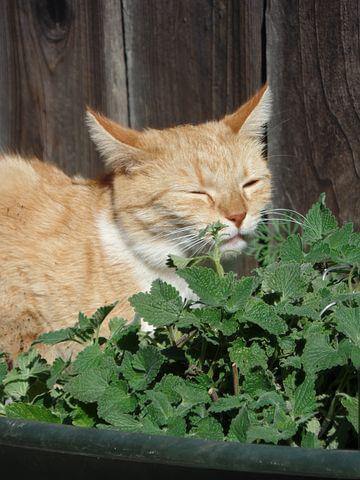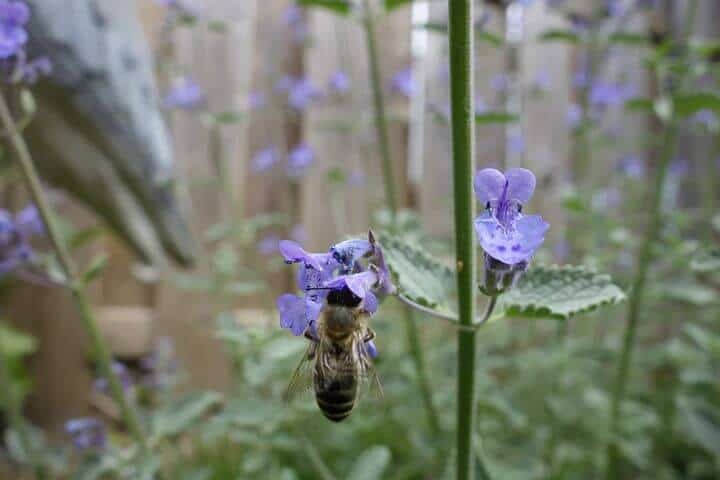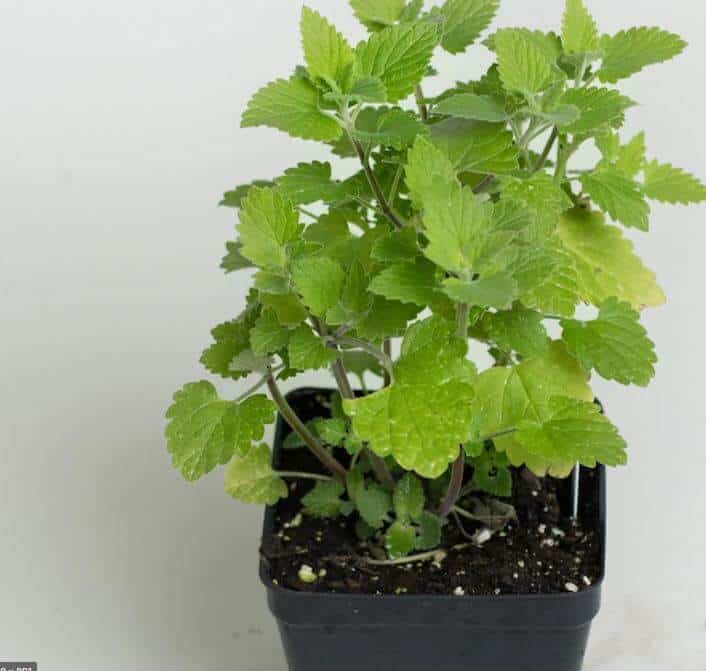Last Updated on January 12, 2023 by a Friendly Gardener
Whether you are passionate about cats or a lover of herbal teas, consider adding every kitty’s favorite herb to your garden. Botanically known as Nepeta cataria, catnip is a perennial herb that can turn your backyard into a haven for felines with its cultivation. It contains the chemical nepetalactone that is attractive to felines whether domestic or wild. Kitties will munch on the foliage or roll in it. Your cat can become lively and playful or aggressive and nervous, purring and drooling depending on individual sensitivity. Some cats are unaffected by it.
You can also grow a plant in your indoor garden for a cup of tea. A member of the mint family, catnip tea is used to help with insomnia, nausea, and light headaches, and some people swear by applying foliage directly to joints affected by arthritis.
If your area is frequented by numerous felines, you may want to protect your plant from neighborhood cats by cultivating it in an enclosed area, or indoors in a hanging basket as long as it is well out of reach. It is important to know that the plant itself is often a magnet to felines but the oils are technically toxic to them.
Catnip also is effective as a companion crop in vegetable gardens to keep pests away from the fruits of your labor. It is a rapid grower and will need to be kept in check. It works well against ants, aphids, cabbage loopers, cockroaches, flea beetles, squash bugs, and weevils to name a few. It also seems to keep mice at bay. Catnip blooms will attract honeybees, making this plant a very proactive member of any garden.
Selecting a Location

Well-draining soil and lots of sunlight exposure are the optimal characteristics for any location where you want to raise catnip. Avoid planting it near trees or taller plants that will create shade, unless you live in a very hot climate, where a bit of afternoon shade will be appreciated. This herb also grows very well in pots, raised garden beds, or along walls where there is an imposed boundary to limit its spread.
Light
Catnip likes full sun for at least six hours daily. If sunlight is inadequate, your plant may become leggy and produce limited foliage. It will have difficulty if the heat is too extreme, so hot climate dwellers will need to offer a bit of afternoon shade.
Soil
A not overly fussy plant, catnip just wants good drainage. Prepare the soil for planting by amending it with compost before positioning plants. Soil pH can be a little acidic to a little alkaline and this herb will do well in rocky soil as well as dry or poor-quality soils.
Water and Humidity
Because catnip is drought tolerant, it will not do well in soggy soil. If soil is waterlogged, it will be fatal. The soil bed for seedlings does need to be consistently moist but never wet. Mature catnip does not require excessive watering unless your area is subject to prolonged periods of drought. If you notice foliage wilting a bit, give your plants a drink. If your area is instead subject to high humidity, make sure the air circulation is good to prevent fungal growth.
Temperature
A temperature that measures between 55° and 85° Fahrenheit is fine. Catnip will experience some struggle if climates are particularly hot and humid.
Feeding
Feeding won’t be necessary unless your soil quality is very poor. In this case, you can add a layer of compost at the beginning of every spring or use a good-quality liquid fertilizer.
Pollination

The catnip plant is self-pollinating and will attract pollinators to your garden.
When to Plant
Catnip should be planted in the spring when there is no more risk of frost in your zone. If you plan on cultivating from seeds, begin your seed trays indoors six weeks before the final frost date for your area.
How to Plant
When using nursery-acquired plants, space them 18 inches to 2 feet apart in your selected garden space. Place the seedlings at the identical depth as the container provided. Cover round seedlings and plants with soil.
Growing from Seed
Seeds should be started six weeks before your final projected spring frost date. Freeze your catnip seeds overnight. Immediately following the freezing, soak them for 24 hours in water. Plant the seeds in a tray of seed starter mix approximately 1/8-inch deep. Find a warm spot to place them that also offers bright indirect light. Keep the soil bed moist and seeds should germinate in a couple of weeks. Transplant when there is no longer a risk of frost.
Cultivation in Pots

This is a good option if you don’t want the plant invading the rest of your garden or yard. Containers should be at least a foot in diameter with drainage holes. Terra cotta is the best as it helps with moisture wicking. Use a well-draining potting mix. Repot every two years.
Pruning Catnip
Catnip reaches its mature size within a single growing season. Pruning is used primarily to control the spread and excessive growth. Prune blooms as soon as they begin to fade and before they seed. Trim new shoots and runners and pinch back stems to stimulate bushier growth. Once the first fall frost appears, cut back plants to a few inches above the soil bed surface. The plant will regenerate in spring. As a perennial, it returns every year.
Catnip Propagation
Catnip spreads without the need for help. You can propagate using stem cuttings in spring or early summer or by root system division.
Propagation with Stem cuttings
- Cut a 4 to a 6-inch stem section at a 45° angle below a leaf node.
- Remove any foliage on the bottom half of the stem section.
- Place the cutting in water or a soil bed and place it in a warm location with indirect light.
- Change the water daily or maintain the soil consistently moist.
- Roots will appear in about a week. When new foliage appears transplant your cutting into a pot or the garden soil bed.
Propagation by Division
- Remove the plant from the soil bed taking care not to damage roots.
- Using sterile garden shears, divide the root clump in half.
- Replant the two halves separately in pots or the garden bed.
Catnip Problems
Catnip is pretty pest resistant. The principal risk for this plant is root rot due to overwatering or poorly draining soil. You may face more damage from felines rolling over your plants.
Harvesting Catnip
Catnip should be harvested when it blooms ideally in the late morning after the dew is no longer present but before the heat hits. Simply cut the entire stem at the base. This herb is used in its dry form and can be inserted in cat toys, sachets, or tea strainers. Hang harvested stems in bundles upside down in a dark, dry location that is well-ventilated. This should be done immediately after harvesting. You can hang them inside a paper bag so that leaves or foliage that drops as it dries can be caught in the sack. After three weeks your catnip should be dried. Crumble it and use it as desired.
Catnip or Catmint?

Nepeta cataria and Nepeta mussinii are often confused. Both are characterized by square stems and gray-green foliage. Catmint will bloom longer with purple flowers, whereas catnip blooms are predominantly white. Catmint also distinguishes itself because it does not attract felines and is an optimal choice for landscaping as it maintains its form.
Catnip Varieties

Together with Nepeta cataria, other plants known as catnip include:
- Nepeta camphorate – Camphor catnip that will not grow taller or wider than two feet.
- Nepeta citriodora – Lemon catnip, which is a slightly smaller plant, and boasts a pleasant citrusy fragrance.
- Nepeta parnassica – Greek catnip which is also a smaller plant and features pink blossoms.

